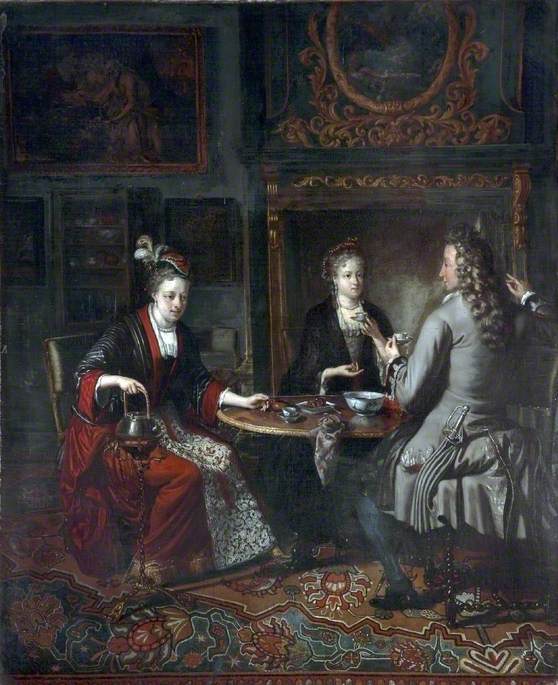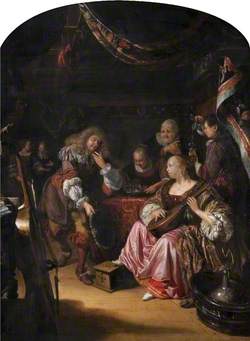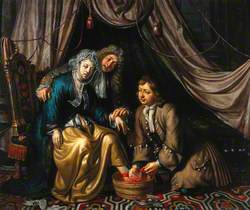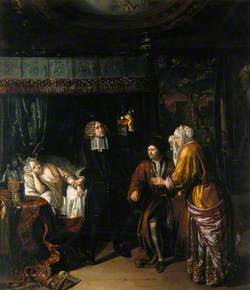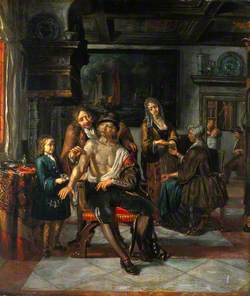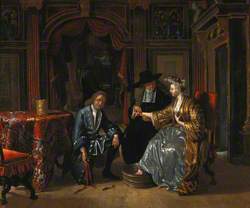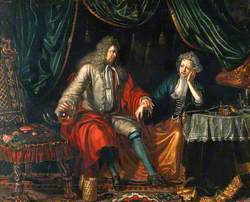How you can use this image
This image is available to be shared and re-used under the terms of the Creative Commons Attribution-NonCommercial-ShareAlike licence (CC BY-NC-SA).
This image can be reproduced in any way but your use of it cannot be for any kind of commercial purpose. Any work you create using this image must also be
Wherever you reproduce the image or an altered version of it, you must attribute the original creators (acknowledge the original artist(s), the person/organisation that took the photograph of the work) and any other stated rights holders.
Review our guidance pages which explain how you can reuse images, how to credit an image and how to find more images in the public domain or with a Creative Commons licence available.
DownloadNotes
Add or edit a note on this artwork that only you can see. You can find notes again by going to the ‘Notes’ section of your account.
In this painting a man and two women are drinking tea in a richly decorated interior. They can be identified as Jacob Cromhout (1671–1722) and his wife (and niece) Elisabeth Jacoba Cromhout (1683–1737), and her sister Maria Cromhout (1691-1726) in their Amsterdam home, Herengracht 366. The Cromhouts sit in the 'franse sael' (French salon) at a precious tea table, a special sideboard holds the tea supplies. The lady of the house takes a kettle from a high, slender stand and pours the hot water into a small brown earthenware teapot. They drink the exclusive and costly tea from tiny blue and white china cups. A charger with pastries and a big china bowl for waste are also on the table. In the second half of the 17th century drinking tea became all the rage, following the example set by the nobles in the circle of the court of the Prince of Orange.
Jacob Cromhout was 'heer' (lord) of Nieuwerkerk and 'hoofdingeland' (governor of a polder) of the Beemster, a great art connoisseur and cognoscente of splendid houses. In 1717 he commissioned the 21-year old painter Jacob de Wit to decorate his country house in the Beemster with a number of 'historiestukken' (historical representations). In 1718 Jacob Cromhout and his wife moved into their new home in Amsterdam, and decorated the rear facade with both their coats of arms. They refurbished the living room into a 'franse sael' with ceiling paintings by Jacob de Wit, who became instantaneously famous.
Matthijs Naiveu painted till 1721. As far as we know this is the last painting he made for the Cromhout family.
Title
Afternoon Tea in Holland
Date
c.1720
Medium
oil on canvas
Measurements
H 88.9 x W 73.6 cm
Accession number
SOPAG:97
Acquisition method
gift from John Henry Bell Esq., 1904
Work type
Painting
Art Detective discussions
Through Art Detective, you can help us to discover more about this artwork. Public collections around the country have many more artworks in need of research. Find out how you can get involved.
